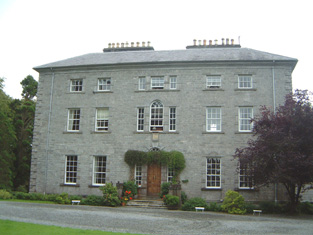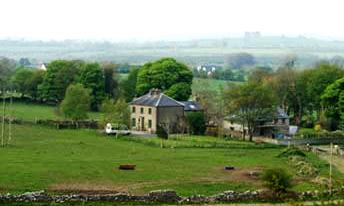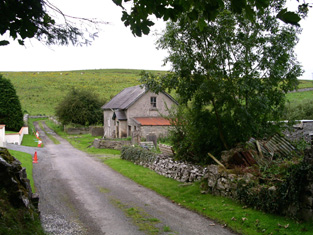Greyfort Cottage
Houses within 10km of this house
Displaying 39 houses.
Houses within 10km of Greyfort Cottage
Displaying 39 houses.
| House name | Description | |
|---|---|---|
| Hollybrook | This house was built in the 1750s as a successor to an earlier castle. The estate passed to the Phibbs family later in the 18th century and Wilson refers to it as the seat of William Phibbs in 1786. It was later bought back by another member of the ffolliott family. McParlan described it as "a very good house" in 1802. At the time of Griffith's Valuation it was the property of John Ffolliott. In 1906 it was the property of Agnes ffolliott when the house was valued at £55. During the twentieth century Hollybrook was run as a hotel for a number of years but it is now privately owned. The house is still standing but does not appear to be occupied. |

|
| Corradoo Lodge | At the time of Griffith's Valuation William Phibbs was leasing the property at Corradoo, barony of Tirerrill to Major Kingston Lloyd when it was valued at £18. Lewis records it as a residence of William Phibbs. McTernan notes that it was originally built by the Phibbs estate as a schoolhouse but was later converted into a residence. It was leased, and later sold to, the Frazier family. Following the deaths of the last of that family it was demolished and a new house built at the site. | |
| Lakeview (Kilmacallan) | Johnston states that Lakeview House was built sometime in the 1780s. It is recorded as a seat of the Weir family throughout the nineteenth century. At the time of Griffith's Valuation it was held by the representatives of William Weir and was valued at £10. Johnston asserts that the house was sold in 1863 and was occupied in the 1870s by Bernard Cogan. It is no longer extant. | |
| Heapstown | At the time of Griffith's Valuation James McTernan owned the house at Heapstown valued at £3 but part of a land holding of 100 acres. Lewis had recorded Heapstown as the seat of Martin Manning in 1837. In 1906 Heapstown was valued at £15. McTernan states that this was the house built after the Famine by Hugh McTernan. This house was eventually demolished in the 1950s. | |
| Abbeyville | Abbeyville was originally a Phibbs property. McTernan states that it was leased to William Fleming after the death of William Phibbs in 1785.The original house was built in 1716 but extensively modernised afterwards. In 1814 it was the residence of William Fleming. At the time of Griffith's Valuation it was being leased by James Fleming from William Phibbs and was valued at £6. In the later nineteenth century it passed out of the Fleming family. It was demolished in the later twentieth century. Leet indicates that Archibald Fleming resided at Larkfield, also close to Ballymote. | |
| Cloonshanbally | Margaret and Henry Gorman were leasing a property valued at £12 at Cloonshanbally, barony of Tirerrill, from the Gore Booth estate at the time of Griffith's Valuation. | |
| Earlsfield | Earlsfield had earlier been a Dodwell property. At the time of Griffith's Valuation it was leased from the Gore-Booth estate by Capt. Richard Gethin and was valued at £20. Slater records it as the seat of Francis Gethin in 1894. It is still extant and has served as a convent for many years. |

|
| Newpark | At the time of Griffith's Valuation Newpark was being leased by Jemmet Duke from Robert Duke and was valued at £25. Lewis recorded it as the seat of Robert Duke in 1837. McTernan notes that it passed by sale to Richard Edward O'Hara of the Annaghmore family in 1913. The house is still extant and occupied by his descendents. |

|
| Battlefield | McTernan notes that Battlefield was built for the Knott family in the early nineteenth century. At the time of Griffith's Valuation James Knott occupied the property, then valued at £20. Both Leet in 1814 and Lewis in 1837 record Battlefield as a residence of the Knott family. In the later nineteenth century the house passed into the ownership of the Robinson family, descendents of the Knotts. with whom it remained until the 1940s. It was sold and subsequently demolished. | |
| Tower Hill | At the time of Griffith's Valuation, Richard Gardiner was leasing a property valued at £14 at Carrowkeel, barony of Tirerrill, from Viscount Lorton's estate. He was also renting over 400 acres. McTernan indicates that the family held property in the area since the mid eighteenth century. The original house was damaged by fire in the 1960s but another was built at the site and is still in the possession of the Gardiner family. | |
| Clooskirt | At the time of Griffith's Valuation, Mrs. Ormsby Gore was leasing this property to William Wilson. It was then valued at £12. At the same time Ruttledge Burrowes was leasing a property valued at £4 with over 140 acres of land from the Ormsby Gore estate. Johnston states that a "model farm" was established here in the later nineteenth century. This townland is mentioned as Clooshire, in 1906, when George Ormsby Gore was the owner of the property but there is no valuation given for buildings at that time. It was subsequently lived in by the St. Lawrence family. |

|
| Rockbrook | Rockbrook was originally a Phibbs property. It later came into the possession of Abraham Martin of Cleveragh who leased it to the Cogan family and later to the Lougheed estate. It was occupied by John Lougheed at the time of Griffith's Valuation when it was valued at £3. Johnston states that the estate was divided by the Land Commission in the 1920s and that the house was sold by Mrs. Lougheed in 1938. It burnt down in 1945 and only the ruins remain today. | |
| Castle Neynoe/Ballysumaghan House | At the time of Griffith's Valuation, Richard B. Neynoe was leasing property at Ballysumaghan, barony of Tirerrill, to Henry Griffith, when it was valued at £30. Johnston states that Griffith changed its name to Ballysumaghan House. In 1906 it was the property of M.F.B. Stack. The house was stripped and the contents auctioned in the 1930s. Castle Neynoe was a ruin for many years but began to be restored in 2007. |

|
| Lisconny | Lisconny was a property which belonged to the Phibbs family in the eighteenth century. McTernan notes that it had been purchased by them from the Mortimer family in the 1770s. It passed to the Toler family, earls of Norbury, through marriage. At the time of Griffith's Valuation, it was occupied by Bernard Owen Cogan, leasing from Lady Norbury's estate. It was then valued at £20. Lewis also records it as being occupied by the Cogan family in 1837. Johnston asserts that the Cogans acted as agents for Lady Norbury's estate in Ireland. The house was demolished early in the twentieth century. Very few traces remain except some walls of the stable yard and a building which had been an annex to the big house. | |
| Ballindoon House | Ballindoon or Kingsborough House in the townland of Kingsborough was built c.1820. An earlier house, known as Kingsborough, stood on the site.At the time of Griffith's Valuation, John Gethin was in possession of the house at Kingsborough which was valued at £20. In 1906 Percy Gethin owned the property then valued at £22. The house is still extant. |

|
| Coopershill | Coopershill House was completed in 1774. McParlan described its situation as delightful in 1802. Lewis records it as the seat of Arthur Cooper in 1837. At the time of Griffith's Valuation it was occupied by Charles William Cooper and valued at £52. Charles William Cooper later succeeded his uncle as owner of the O'Hara of Annaghmore estate and henceforth Coopershill bacame an O'Hara property. He is recorded as the owner in 1894. The house is still extant and run as a guesthouse by the O'Hara family. |

|
| Ballynashee Lodge [Geevagh Lodge] | At the time of Griffith's Valuation Michael Keogh owned Ballynashee Lodge, valued at £22. In 1906 George Keogh was the owner of the mansion house at Ballynashee valued at £22. Lewis also records this house as a seat of the Keogh family in 1837. It is labelled Ballynashee Lodge on the 1st edition Ordnance Survey map but as Geevagh Lodge on the later 25-inch edition of the 1890s. A later building is still extant at the site. | |
| Annagh Lodge | At the time of Griffith's Valuation, Thomas Whitney was leasing a house valued at £12 to Edward Frazer, at Aughnacloy, barony of Tirerrill. In 2006 Annagh Lodge was offered for sale by Raymond Potterton estate agents, in county Meath. The house details claim that Annagh Lodge was built by the Frazer family (from Scotland), around 1800. McTernan, however, notes that the house was reputedly built by a landlord named Hewitson. |

|
| Spotfield | Spotfield appears to have been the property of the Phibbs family in the 19th century but in the 18th century may have been occupied by the White family who had intermarried with the Phibbs. At the time of Griffith's Valuation, it was leased by John Phibbs to Eccles Phibbs. The house was then valued at almost £4. McTernan notes that the house was demolished in the latter part of the twentieth century. | |
| Tanzyfort | Tanzyfort House was built by the Cooper family in the mid-17th century and occupied by them until the completion of Coopershill House in 1774. Wilson, however, still refers to it as the seat of Arthur Cooper in 1786. Orser provides a detailed description of the layout of Tanzyfort House. | |
| Drumdoe | At the time of Griffith's Valuation, John Wolfe Flanagan was leasing a house at Drumdoe from Viscount Lorton's estate, valued at £28. This house is described as "a good house, formerly the residence of Colonel Lilly" at the time of the first Ordnance Survey. A larger house was constructed some time after this and appears on the 25-inch map of the 1890s. This latter house is still extant. | |
| Mount Dodwell | Henry Crichton was the owner of a property valued at almost £7 at Ballinvoher, barony of Corran, in 1906. This may be the cottage which is still extant and was possibly a steward's house. At the time of Griffith's Valuation, it was being leased by Samuel Gilmore from the Creighton estate and was valued at £5. Lewis records Mount Dodwell as the residence of Charles Thompson, who was related to the Dodwell family. This was the original house, which had stood here since the eighteenth century. It ceased to be a residence in the mid-nineteenth century and was subsequently demolished. |

|
| Carrick House | Johnston states that Carrickcoola was owned by the Ormsby Gore estate but was the residence of the McLoghrey family. McTernan indicates that the original house was of two stories but that this was later replaced by a single storey building. The Ormsby Gore estate owned 22 acres of untenanted land in Carrickcoola, barony of Tirerrill, in 1906 but the buildings are not listed. At the time of Griffith's Valuation, Maj. Ormsby Gore owned the townland and was leasing a house valued at only 10s to Thomas McCloghrey together with over 130 acres. | |
| Kingston Lodge | Johnston states that Kingston Lodge was a residence of the McLoghry family. McTernan notes that it is a mid to late nineteenth century building, built by Henry McCloghry, son of Thomas McClogry of Carrickcoola. It was being leased by him from the Cooper estate at the time of Griffith's Valuation and valued at almost £4. The house remained in the McCloghry family until the 1940s and is now in a derelict state. | |
| Ardagh | At the time of Griffith's Valuation Richard Graves Brinkley held extensive property at Ardagh and Bellanascarva, barony of Tirerrill. This had formerly been part of his wife, Hester Lloyd's estate. Ardagh House was then valued at £14. Johnston states that the property at Ardagh was later lived in by Hunter family who acted as agents for the Brinkley estate. Part of the extensive farmyard of Ardagh House has been converted into residential accommodation. An extensive mill complex in the nearby townland of Bellanascarva was leased to Munds Harper at the same time where Brinkley also held a house valued at £30. |

|
| Lissycoyne | At the time of Griffith's Valuation, Patrick McDermott was leasing a property valued at £7 at Lissycoyne, barony of Tirerrill, from the Brinkley estate. It is shown as diminished in size on the 25-inch Ordnance Survey map of the 1890s. Some farm buildings are located at the site now. | |
| Branchfield (Duke) | At the time of Griffith's Valuation Alexander Duke was leasing property valued at £8 with almost 300 acres, at Branchfield, barony of Corran, from Jemmet Duke. Lewis records Branchfield as the seat of Rev. William Duke in 1837. Wilson notes Branchfield as the seat of Mr. Duke in 1786, remarking that the ruins of Coolteem Castle are nearby. Branchfield House has been offered for sale in recent times. |

|
| Kilcreevin | Lewis records Kilcreevin as a seat of Jemmett Duke in 1837. Griffith's Valuation shows that Jemmett Duke was leasing over 250 acres from the Coopers of Markree in this townland including a property valued at £2. |

|
| Kilmorgan | Jemmet Duke held 220 acres at Kilmorgan, barony of Corran as well as a property valued at £5 at the time of Griffith's Valuation. Lewis had recorded Kilmorgan as the seat of Robert Weir. McTernan notes that Kilmorgan had belonged to the Trumble family but was sold by them in 1855. The site is now occupied by farm buildings. | |
| Carrickard | At the time of Griffith's Valuation, Rev. Arthur Hyde was leasing a house at Carrickard, barony of Tirerrill from the estate of Robert Gough. The house was valued at £8. | |
| Brick Field | At the time of Griffith's Valuation William Phibbs held a property valued at £6 at Knockbrack, barony of Corran. In 1906 this property was valued at £11. | |
| Andresna | Meredith Thompson was leasing a property valued at £6 at Andresna, barony of Tirerrill, to William Thompson at the time of Griffith's Valuation. | |
| Castlefield House | At the time of Griffith's Valuation Meredith Thompson, senior, was occupying a house valued at over £5 at Anresna, barony of Tirerrill. This appears to be the house marked on the OS map as Castlefield House, on the shores of Lough Arrow. McTernan notes that it later came into the possession of the Acheson family who sold it in 1935. It is still extant but in 2009 was unoccupied. | |
| Keenaghan Mill | At the time of Griffith's Valuation John and Henry Gorman were leasing an extensive milling complex at Keenaghan, barony of Corran from Robert Gore Booth, then valued at £83. |

|
| Derroon House | Derroon House is recorded on the 1st edition OS map. At the time of Griffith's Valuation, Capt. Richard Gethin was leasing a property at Derroon from the Gore-Booth estate valued at almost £3. | |
| Straduff Lodge | Patrick Martin was leasing a property valued at £3 from the Keogh estate at Straduff, parish of Kilmactranny, at the time of Griffith's Valuation. This property appears on the 1st edition OS map as Straduff Lodge. It is no longer extant. | |
| Templevanny | McTernan notes that Templevanny House was commenced in 1846 but not completed until after the Famine. At the time of Griffith's Valuation, it was held by Margaret and Henry Gorman from Viscount Lorton's estate with a valuation of £2. It continued in the Gorman family until the 1920s. The building is still extant though derelict. | |
| Crohy House | Crohy House was occupied by Francis Foster, leasing from the Conyngham estate at the time of Griffith’s Valuation. | |
| Roshin Lodge | Francis Foster was occupying Roshin Lodge at the time of Griffith’s Valuation. It was leased from the Conyngham estate and valued at £18. Foster's daughter, Mary Stewart Foster, married John Stouppe Charley of Belfast. She sold the property after his death. In 1876 it was offered for sale by Arthur Sandys Forster. Roshin Lodge was described as 'a spacious dwelling house, comprising 29 apartments' at that time. By 1901 it was the residence of William Smyth and his family. He had died by 1911 but his widow and children still occupied the property. |

